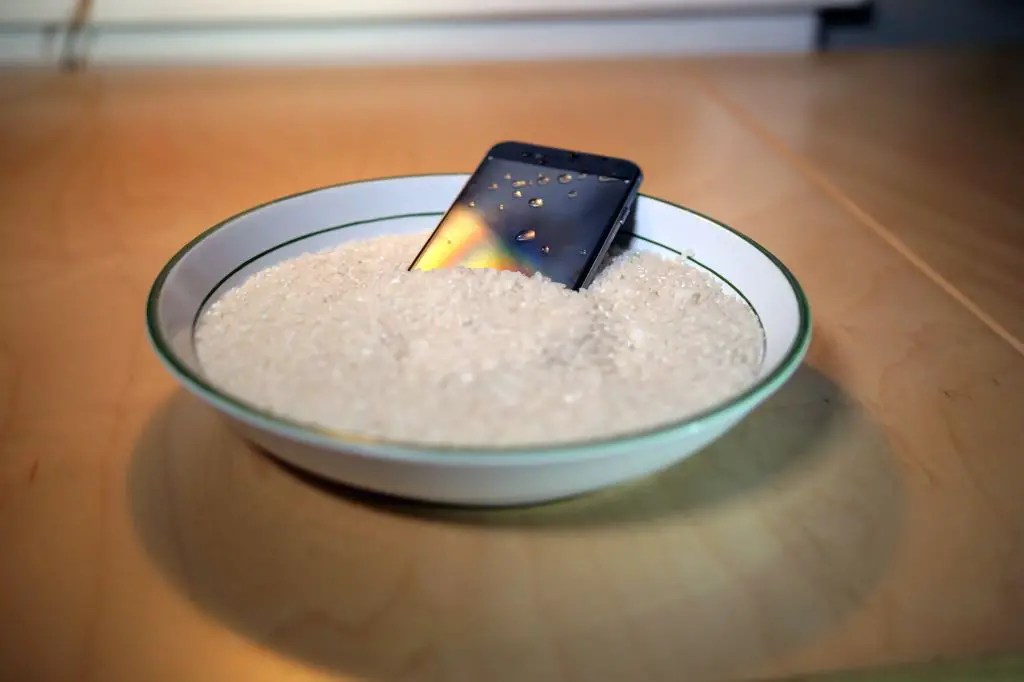Quick Answers
If your phone fell into water and won’t turn on, here are some quick things to try:
- Remove the battery immediately and dry out the phone with a towel.
- Do not try to turn on the phone while it’s wet.
- Use a hairdryer on low heat setting to dry out the phone.
- Place the phone in a bag or container of uncooked rice to absorb moisture.
- Bring the phone to a repair shop if rice doesn’t work.
Assessing Water Damage
When a phone is exposed to water, the water can damage electronic components and cause short circuits. The severity of the water damage depends on:
- Amount of water – More water means more chance for damage.
- Type of liquid – Saltwater and chlorinated water are more conductive.
- Length of exposure – Longer exposure means more water can get in.
- Depth of water – The deeper the water, the more pressure forcing water into the phone.
- Phone construction – Some phones have water-resistant casings.
Signs of severe water damage include the phone not powering on at all, distorted or blurry screen, microphone or speaker not working properly. Lesser damage may just disable certain functions of the device.
Step 1: Remove Power Source and SIM Card
As soon as possible after the phone gets wet:
- Remove the battery from the phone if possible. This prevents currents from running through water-logged circuits.
- Remove the SIM card. The SIM card stores valuable personal data you don’t want to lose.
- Pat dry the phone gently with a clean towel or cloth. Do not rub the screen. Absorb any liquid rather than spreading it around.
- Do not try to power on the phone while wet. This could short circuit the device.
Step 2: Dry Out the Phone
Water will evaporate slowly on its own, but moisture left inside can lead to corrosion. Use one of these methods to thoroughly dry out the phone:
Hair Dryer Method
- Use a hair dryer on the lowest heat setting to avoid damaging phone components.
- Hold the dryer 6-8 inches away and keep it moving to spread warm air evenly.
- Aim the dryer into phone ports and buttons to evaporate trapped moisture.
- Dry for at least 30 minutes, checking hard-to-reach areas for moisture.
Rice Method
- Place the phone in a sealable bag filled with uncooked rice. Rice absorbs ambient moisture well.
- Bury the phone in rice so grains contact all surfaces.
- Seal the bag and let sit for 24-48 hours.
- Check the phone interior afterwards for any condensation or wetness.
Drying Kit
- Use a drying kit containing moisture-absorbing beads or packs.
- Follow kit instructions for optimal drying time, which may take 3-5 days.
- Phone drying kits are available at electronic stores or online.
Step 3: Cleaning and Maintenance
Once the phone is fully dry inside and out:
- Use compressed air to blow out any remaining moisture in cracks and ports.
- Clean off corrosion buildup on the battery and connections with a metal polish.
- Inspect displays and cameras for water spots and clean carefully.
- Reassemble the phone properly and test functions one by one.
To Prevent Future Water Damage
- Avoid exposing your phone to moisture when possible.
- Use a watertight case for wet environments.
- Keep phones away from sinks, tubs, pools.
- Never use a phone while it’s wet.
When to Seek Repair Service
If the phone shows no signs of functioning even after thorough drying and cleaning, it likely has internal damage that needs professional service. Seek phone repair if:
- Phone does not power on at all.
- Display is distorted, blurry, or has dead pixels.
- Speakers, microphone, or camera do not function.
- Corrosion is visible on electronic components.
- Buttons and ports no longer respond.
- Battery will not charge properly.
Phone repair shops have tools to accurately diagnose issues and access internal components. Common repairs include:
- Replacing damaged electronic boards
- Cleaning corrosion from circuits
- Reflowing solder joints
- Bypassing shorted wires and connections
The cost of professional phone repair varies depending on the model, damage level, and replacement parts needed. Phone manufacturers may also offer repair services through authorized service centers.
Data Recovery Tips
Water exposure can make data recovery from the phone’s internal storage challenging. Try these methods:
- Remove the SIM card and memory card from the phone before drying. These can be read by another phone.
- Once dried, connect the phone to a computer and copy over any accessible files.
- Cloud backups can restore contacts, photos, and other data synced prior to water damage.
- Data recovery services use specialized tools to physically repair drives and extract data.
Conclusion
Severe water damage can ruin a phone beyond repair, but quick action greatly improves the chances of reviving it. Remove power sources immediately, thoroughly dry the phone with rice or a drying kit, and seek professional repairs if needed. With some luck and patience, a water-damaged phone can make a full recovery.
